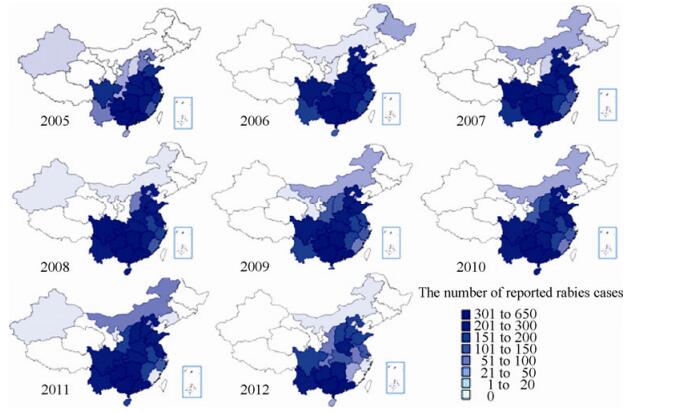-
Dear Editor,
We report the results of a preliminary investigation of data collected between 2005 and 2012. A National Human Rabies Surveillance program was initiated in high rabies incidence regions in 2005, and subsequently carried out nationally to monitor rabies situation. Our work presents a summary of epidemiological and etiologic rabies surveillance data collected since the implementation of the program.
Rabies is a zoonotic infectious disease caused by rabies virus (RV) and has reported across almost the whole world (WHO, 2005). Most warm-blooded animals are susceptible to the rabies virus. In China, the domestic dog acts as the main reservoir of the rabies virus and plays a pivotal role in human rabies infection (Tang X, et al., 2005). Rabies is an acute infectious disease with a human mortality rate of almost 100% after the onset of symptoms (Yu Y X, 2009).
Beginning in 1996, China witnessed its third rabies epidemic wave (Hu R L, 2007; Si H, et al., 2008). Annual human incidences were 159 in 1996 and peaked at 3302 in 2007 (Song M, et al., 2009; Yin C P, et al., 2012). Meanwhile, the geographical distribution has shown a gradual expansion, with a general diffusion from high incidence to low incidence regions, such as Shanxi, Inner Mongolia, Shaanxi and Yunnan (Fig. 1). According to the epidemiological data from the National Disease Reporting Information System of the China CDC, all Chinese provinces or regions reported human rabies cases between 2005 and 2012 with the exception of Tibet. Although western provinces (such as Tibet, Xinjiang, Qinghai, Gansu and Ningxia) and three northeast provinces (Heilongjiang, Jilin, and Liaoning) have no or very few cases, they remain under threat of import of rabies cases from neighboring epidemic regions (Guo Z, et al., 2013; Yu J, et al., 2012).
To learn more about the epidemic, from 2005 to 2012, 9996 samples in 20 provinces were collected, including the brain tissue of dogs and cats and some wildlife (Ferret badgers) where possible, and the brain tissue or fluid of the suspected human death cases (Table 1). Guangxi, Guizhou and Hunan were the regions with severe rabies epidemics where the monitoring program was first implemented. Because of the local custom of eating dog meat, the initial investigation focused on collection of brain specimens of dogs raised by the local villagers for sale in local dog restaurants (Li. H, et al., 2008) and from animals or humans exhibiting the symptoms of rabies. Subsequently, specimens were collected from animals or humans exhibiting symptoms of rabies in other provinces.

Table 1. The collective and detective results of specimens, 2005-2012.
All the collected specimens were tested to confirm the presence of rabies virus. First, rabies specific antigen was detected in brain specimens using rabies direct immunofluorescence assay (DFA) as described elsewhere (Yu. J N, et al., 2010). The positive specimens were further tested for presence of the rabies virus nucleic acid by RT-PCR. The specimen RNA was extracted with a QIAamp Viral RNA Mini Kit (QIAGEN) and used as template for a cDNA library with the random primer pd(N)6 (TaKaRa, Japan) and a reverse transcription reaction Kit Ready-To-Go You-Prime First-Strand Beads (GE Healthcare), then detected with nested PCR (Tao X Y, et al., 2009).
364 positive specimens were obtained after DFA and RT-PCR detection, accounting for 4% of the total specimens (Table 1, Table 2). Few positive samples were identified from apparently healthy dog specimens collected from the high incidence provinces of Hunan, Guangxi and Guizhou (Li H, et al., 2008). The numbers of positive cases in dogs exhibiting symptoms of rabies was significantly higher. In particular, the brain specimens of wounding dogs in Shanghai, Guangdong and Tibet, the specimens of the clinically reported cases in Shanxi and Ningxia and the saliva sample of an imported case collected from Beijing Infectious Hospital in 2012 were all positive after laboratory verification. No human cases was previously reported in Tibet, therefore the isolates collected from dogs in 2012 is of particular concern. In Yunnan and Inner Mongolia positive specimens were isolated from cows, and epidemiological data showed that the farm with the infected cows had reports of dogs biting cows and positive specimens from the dogs were also detected.

Table 2. The detection results of specimens in different years and hosts
Although domestic dogs play a pivotal role in transmitting rabies, more and more reported human cases were caused by wild animals such as wolf, marten, bear, wild boar, deer and rabbit (Yu Y X, 2009). The potential for increasing contact between wild and domestic dogs poses a new challenge for future rabies control. Positive detection of RV in ferret badger specimens collected in Zhejiang in 2008 and 2011 suggests the necessity of wildlife monitoring.
According to the analysis of the 196 specimens collected from 161 patients (Table 3), the brain specimens had the highest positive rate (100%), followed by the saliva and cerebrospinal fluid (14%-25%). Though the brain specimen had the highest specificity for rabies diagnosis, it can only be collected after death and only with the consent of the patient's relatives (Hu R L, 2007). However, the saliva, blood and cerebrospinal fluid can be used for laboratory investigation, but the results can be affected by the sampling method, collection time and storage conditions. It was reported the positive rate of the virus isolated from saliva is about 59% (Hu R L, 2007). In our study the positive rate of the saliva was 25% and that for the cerebrospinal fluid was 14.3%, which might be associated with the clinical sampling method, the specimen delivery and antibody prevalence in the body.

Table 3. The pathogen detection results of suspected case specimens
In conclusion, our findings demonstrate that although dogs still act as the primary rabies host in China, some wildlife animals (such as ferret badger and Apodemus agrarius (striped field mouse)) act as additional hosts that may make a notable contribution to the further spread of the virus. Additionally, there is an increasing number of infections in economically important livestock. Our findings highlight the rapid geographical expansion of rabies and increasing host variety, underlining the urgency of an effective rabies control program. In particular, this highlights the need to implement a comprehensive dog vaccination program, beginning in high incidence provinces. By reducing cases in the primary host, the rabies epidemic can finally be brought under control, reducing the overall impact on country as a whole.
HTML
-
We would like to thank the staff of the provincial CDCs for their help with specimen collection. And, we thank Shu-lin Lang and Cui-Ping Yin for specimen diagnosis. This work was supported by grants from the National Department Public Benefit Research Foundation (201103032, 200803014).














 DownLoad:
DownLoad: